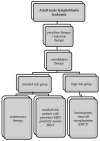Changing Landscape in the Treatment of Adult Acute Lymphoblastic Leukemia (ALL)
- PMID: 36077822
- PMCID: PMC9454969
- DOI: 10.3390/cancers14174290
Changing Landscape in the Treatment of Adult Acute Lymphoblastic Leukemia (ALL)
Abstract
Acute lymphoblastic leukemia (ALL) is a rare hematological malignancy characterized by proliferation and accumulation of premature lymphoid blasts. Depending on risk factors, the survival of acute lymphoblastic leukemia has significantly improved over the last decades. During the last years, measurable residual disease (MRD) assessment has evolved into one of the most sensitive markers for prognosis and risk of relapse. For this reason, measurable residual disease detection and monitoring count as standard evaluation in patients with acute lymphoblastic leukemia. Allogeneic stem cell transplantation is still the recommended treatment option for patients with high and highest risk profiles as well as for relapsed or refractory settings. The increased understanding of the pathomechanism and heterogeneity of acute lymphoblastic leukemia has led to the development of several novel therapeutic opportunities such as tyrosine-kinase inhibitors, antibody-based therapies and CAR-T cells with the aim of improving clinical outcomes. Furthermore, the major advances in disease understanding of ALL have led to the identification of different subgroups and better disease stratification. Even though novel therapy targets are constantly developed, acute lymphoblastic leukemia remains a challenging and life-threatening disease. To improve the historically unsatisfying result in therapy of adult acute lymphoblastic leukemia many clinical trials have recently been initiated to determine the optimum combination regimens of novel and old agents for adult acute lymphoblastic leukemia.
Keywords: ALL; CAR-T cells; acute lymphoblastic leukemia; antibody-based therapy; chemoimmunotherapy; tyrosine-kinase inhibitors.
Conflict of interest statement
The authors of this review have no conflict of interest to declare.
Figures
References
-
- Hoelzer D., Bassan R., Dombret H., Ribera J., Buske C. Acute lymphoblastic leukemia in adult patients: ESMO Clinical Practice Guidelines for diagnosis, treatment and follow up. Ann. Hematol. Oncol. 2016;27:69–82. - PubMed
-
- Alaggio R., Amador C., Anagnostopoulos I., Attygalle A.D., Araujo I.B., Berti E., Bhagat G., Borges A.M., Boyer D., Calaminici M., et al. The 5h edition of the World Health Organizaion Classification of Haematolymphoid Tumours: Lymphoid Neoplasms. Leukemia. 2022;36:1720–1748. doi: 10.1038/s41375-022-01620-2. - DOI - PMC - PubMed
Publication types
LinkOut - more resources
Full Text Sources


